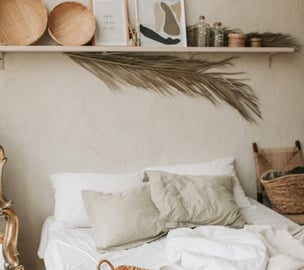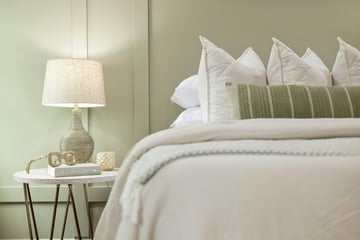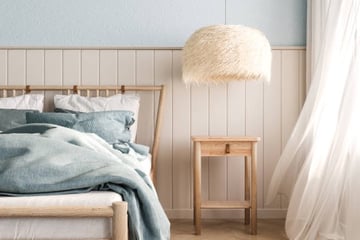The Psychology of Bedroom Colours: What is the Best for Ultimate Relaxation?
BEDROOM


Your bedroom should be a sanctuary—a place where you can unwind, recharge, and escape from the stresses of everyday life. But did you know that the colours you choose for your bedroom can significantly impact your mood and sleep quality? Some shades are naturally calming, while others might unknowingly keep your mind alert.
If you're looking to create a peaceful, sleep-friendly environment, choosing the right colours is a great place to start! Let’s explore the best bedroom colours for relaxation and rest.
1. Serene Blues: A Tranquil Escape
Blue is often considered the most relaxing colour for bedrooms. It evokes feelings of calmness and serenity, much like the vast sky or a gentle ocean. Lighter shades such as soft powder blue, periwinkle, or pastel blue can help lower blood pressure and reduce anxiety, promoting better sleep.
For a cozy and modern look, deeper shades like navy or teal can work beautifully, especially when paired with warm wooden tones or soft lighting.
What Colours Should you Avoid
While some colours are fantastic for relaxation, others can have the opposite effect. Bright reds, neon yellows, and bold oranges can be too energizing, making it harder for your brain to wind down. Similarly, stark whites or overly dark shades can feel either too clinical or too heavy, which may not promote a restful environment.
2. Gentle Greens: Nature’s Comfort
Green is a colour deeply connected to nature, which makes it naturally soothing. Shades like sage green, moss, and mint have a refreshing yet calming effect, making them ideal for relaxation. Green is also associated with balance and renewal, helping to create a sense of harmony in your space.
Pairing green with earthy neutrals like beige, cream, or soft browns can enhance its grounding qualities.
3. Soft Neutrals: Warm and Cozy
Neutral colours such as warm beige, light taupe, and soft gray are perfect for a bedroom that feels cozy and inviting. These shades create a peaceful atmosphere without overwhelming the senses.
Soft neutrals also offer great flexibility when it comes to decorating, allowing you to introduce different textures and accent colours without disrupting the relaxing vibe.
4. Lavender And Lilac: Subtle and Soothing
Lavender is known for its stress-relieving properties, and it’s no surprise that it makes a fantastic bedroom colour. The light purple hue has a calming effect on the mind, helping to reduce tension and promote relaxation.
For a more sophisticated and muted look, opt for dusty lilac or soft lavender instead of brighter purples. These shades pair well with white or light gray for an airy and peaceful feel.
5. Muted Pinks: A Gentle Embrace
While bright pinks can be stimulating, softer shades like blush, rose, or peachy pink create a cozy and restful space. These tones bring warmth and comfort to the room without being overwhelming.
Pairing muted pinks with light neutrals and wooden textures can enhance their calming qualities, making your bedroom feel like a peaceful retreat.
6. Earthy Tones:
Earthy colours like terracotta, soft clay, and warm caramel tones can make a bedroom feel grounding and cozy. These hues bring a sense of stability and warmth, making them excellent choices for a restful sleep environment.
Mixing earthy tones with soft whites and natural materials like linen and wood can create a soothing and welcoming space.
Final Thoughts!
Your bedroom should be a personal haven, and choosing the right colour scheme can play a significant role in how well you relax and sleep. Whether you prefer cool blues, earthy tones, or soft neutrals, there’s a perfect shade to help create the peaceful retreat you deserve.












